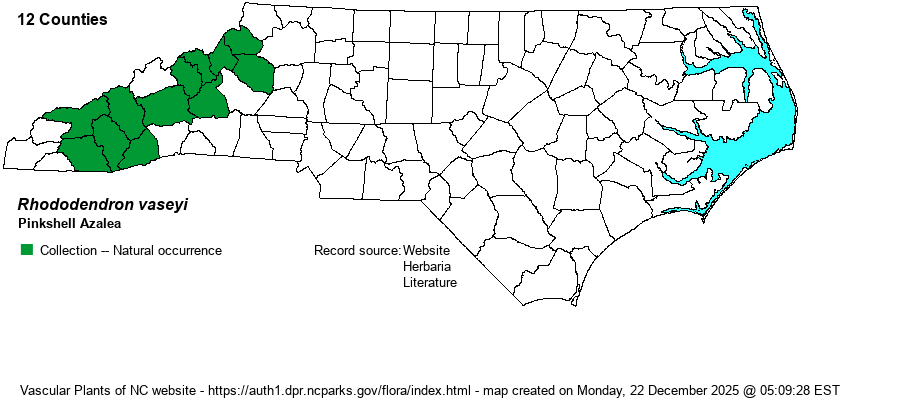| Author | A. Gray | |
| Distribution | Occurs over most of the Mountains, but only at higher elevations. Thus, absent from several counties along the VA border, and also absent from a few extreme southwestern counties. A specimen at herbarium GA from Clay County is actually from Macon County.
This is an NC endemic, despite occurring over a fairly wide north-south range, from Grandfather Mountain (Watauga, Avery, and Caldwell counties) on the north to Macon, Jackson, and Transylvania counties on the south. Though the range lies close to SC, TN, and GA, it has not been reported in these states except for an undocumented report from Rabun Bald in GA.
| |
| Abundance | Though globally quite rare, it is generally uncommon in the state’s high elevations (mainly over 4000 feet), and is not one of the state rarer species. Nonetheless, the NC NHP tracks records of the species as Significantly Rare, but the State does not list it as a legally Protected Species (i.e., as Endangered, Threatened, or Special Concern). | |
| Habitat | The species favors cool, moist, and often exposed sites near the tops of granitic domes, heath balds, ridges, and other rocky summits. It can be found in some moist forests under a canopy at high elevations, such as in spruce-fir forests; and it also occurs in a few bogs and swampy areas, mostly over 3500 feet. |
| Phenology | Blooms in May and June, mostly as the leaves are unfurling, and thus the large rosy-pink flowers are quite visible when in bloom. Fruits from August to October. | |
| Identification | This is a somewhat unique shrub, even though it occurs in a genus of many other shrub species. Though it is a deciduous species of “azalea”, its flowers have only a short floral tube and thus the flowers are mainly widely spreading from the base; there are 5-7 stamens instead of 5 for the other azalea species. It grows up to 15 feet tall, though it averages around 5-6 feet tall. It has considerably larger leaves than the other NC azaleas, and lengths average 3-4 inches long instead of perhaps just 2-2.5 inches long; they also tend to be more elliptical than in other azaleas. Even so, most people will easily overlook this shrub in leaf; the soft rose-pink flowers with quite long stamens are generally needed for identification. The species can often be seen along the Blue Ridge Parkway at high elevations, when in late May and early June the large pink flowers will command attention, such as at Grandfather Mountain and in the Great Balsam Range. | |
| Taxonomic Comments | None
| |
| Other Common Name(s) | Generally none | |
| State Rank | S3 | |
| Global Rank | G3 | |
| State Status | SR-L | |
| US Status | | |
| USACE-agcp | | |
| USACE-emp | FACU link |

